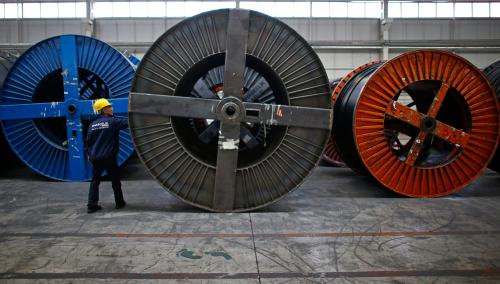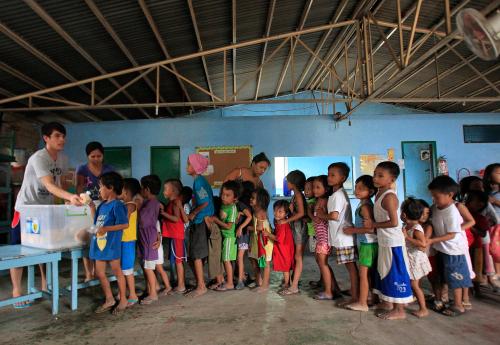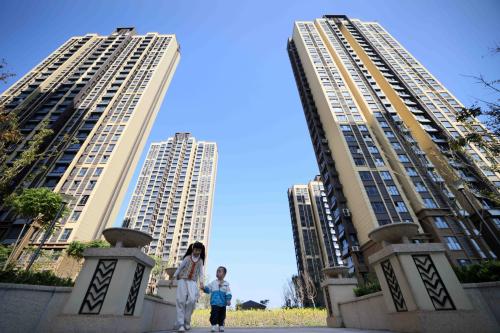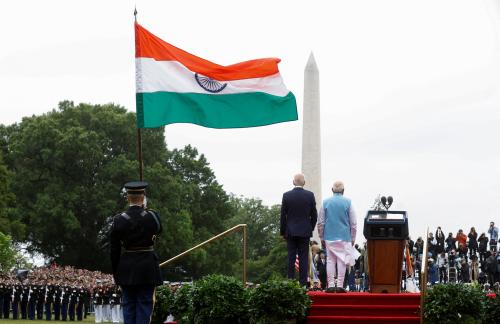Steven Heydemann explores the understudied solidarity-based social mechanisms that have created and sustained economic resilience in the Middle East past, but which are now coming under increasing strain. This piece was originally published by the Lebanese American University.
The political economies of the Arab world present a fascinating but puzzling paradox. On the one hand, the region’s trajectory over the past decade has reflected growing anger and frustration among Arab publics in societies wracked by economic stress and deepening economic precarity. On the other hand, these widely-held economic grievances co-exist with the lowest levels of extreme poverty among developing regions, defined by the number of people living on less than $1.90/day, the current International Poverty Line (IPL).
How can we account for the region’s apparent success in achieving such low rates of extreme poverty even while widely-held economic grievances and anxieties continue to grow and middle classes come under increasing economic strain? Can the relative success in reducing extreme poverty be sustained given the economic collapse of conflict-affected states such as Syria, Libya, and Yemen, or in the face of corrupt, predatory governments in Iraq, Algeria, and Lebanon? How have the economic strains associated with the COVID-19 pandemic affected the least well-off within Arab societies, those who were compelled by necessity to develop effective economic survival strategies?
These are crucial questions for understanding sources of social and economic resilience in the Middle East and North Africa (MENA) region and for exploring the understudied solidarity-based social mechanisms that have created and sustained such resilience in the past, but which are now coming under increasing strain.
For most observers, it is the first of these features that define the region’s political landscape. The uprisings of 2010 and 2011, the more recent wave of protests that erupted in 2019 in Lebanon, Iraq, and Algeria, along with more limited episodes of unrest and labor activism in Egypt and Jordan, are read correctly as potent indicators of the fear, anger, and anxiety felt by millions of people across the Arab world fed up with governments that enable corruption, fail to provide economic security or social mobility, reject accountability, and treat citizens with blistering contempt.
The pandemic’s arrival in March 2020 may have temporarily suppressed protest movements that spilled into the streets in 2019, but the anger that animated them remains a tangible presence across the region, amplified by the grinding hardship that has accompanied the spread of COVID-19.
The outpouring of mass grievances since late 2010, as well as the strategies regimes have developed to contain and suppress popular mobilization, are an understandable focus of attention. Yet the second feature I highlight — the MENA region’s surprisingly low levels of extreme poverty — is no less noteworthy, both because it remains an understudied and underappreciated aspect of the region’s political economies, and because trends of the past decade, now exacerbated by COVID-19, place this achievement at risk.
The following graph from the World Bank makes clear just how low extreme poverty rates are in the MENA region relative to other developing regions in the period up to the start of the Arab uprisings in 2011. Beginning from a low starting point of less than 10% of the population reported to live in conditions of extreme poverty in 1987, the countries of the Middle East and North Africa — at least, those for which data are available — cut that level to around 3% by 2013. In other world regions, such as East Asia and the Pacific and South Asia, declines in extreme poverty were far more rapid, they only approached the levels found in MENA around 2010. And despite their incredible success they continue to show higher levels of extreme poverty than MENA, a region that overall performs less well on many indicators of economic and social development.
Figure 1: Share of population living in extreme poverty by world region (1987 – 2013)

Many economists view the current IPL of $1.90 as too low to capture the much larger numbers of people who scrape by on meagre incomes that barely exceed this level. They view a poverty line of $3.20/day as a more accurate indicator of overall poverty. Not surprisingly, when the $3.20/day level is applied to MENA’s population in poverty increases significantly, as the second graph, below, from a World Bank website, indicates. At this level, the MENA region performs less well than some other world regions yet still has less than half the poverty levels of South Asia and less than one-third of those in Sub-Saharan Africa.
Figure 2: Poverty rates at the $3.20 (USD) line, by region (1990 – 2018)

At either level, but especially if we accept the current IPL of $1.90 as relevant, our opening question remains: How can we account for the performance of MENA in achieving such low levels of extreme poverty? There are any number of candidate explanations, including the possibility that governments lie about poverty data (as we discovered in Tunisia following the overthrow of the Ben Ali regime), and concerns about undercounting the poor. It is unlikely, however, that bad data can explain persistent, systematic regional trends over such an extended period of time, not least because it implies that only MENA’s data are so deeply skewed while data from other developing regions are not.
More plausible possibilities include the legacy effects of very high levels of public spending in MENA from 1965 to 1985, the persistence of high subsidies, the role of remittances in supporting household income, or, more recently, the impact of cash transfer programs, such as the Takaful and Karama programs that provide support to 2.5 million of Egypt’s poorest families. Yet declines in extreme poverty have been consistent, while remittances vary. Public spending in MENA has declined since 1985 even as extreme poverty also declined. And cash transfer programs are a recent phenomenon.
Without dismissing the importance of these factors, I argue that they overlook what could be the most important mechanisms providing a measure of economic security to the region’s least well-off: localized, informal, solidarity-based institutions anchored in personal relationships and social networks that offer the very poor (and sometimes the not so poor) the means to tap into sources of financial assistance and in-kind support that would not otherwise be available.
These mechanisms, I argue, represent crucial sources of social and economic resilience for the least well-off in the MENA region. As Julia Elyachar noted in her book, “Markets of Dispossession”: “The informal economy and the ability of the poor to survive without help from the state, had at their core social networks built around community reservoirs of trust.”
Solidarity-based mechanisms arise in a variety of contexts, from neighborhoods to factories, to bureaucracies, to small enterprises, to urban neighborhoods, and extended families. These are not micro-finance enterprises that are externally funded and conform to practices established by global micro-finance entrepreneurs. They are not created or sustained by international donors. They operate almost entirely outside the scope of the state. And they are anchored in and built up around social affinities of different kinds, including a range of identity-based attributes — neighborhood, village of origin, faith-based identities — that create the conditions of trust within which solidarity networks are able to form and sustain themselves.
Collectively, these informal, localized institutions provide frameworks of trust and solidarity that, in a sense, constitute the micro-foundations of a moral economy.
Collectively, these informal, localized institutions provide frameworks of trust and solidarity that, in a sense, constitute the micro-foundations of a moral economy. Individuals, who belong to such solidarity-based networks often lack the means to fund expenses that arise in moments of need — weddings, funerals, business opportunities — and have thus developed shared norms and practices that network members understand and accept in exchange for access to resources, including a commitment to provide resources in turn to others in the network.
Perhaps the most important and most widespread of these institutions are informal, neighborhood-based rotating credit associations. These are typically run by women, collect dues from members, charge no interest, and make small loans on a rotating basis to association members. There’s been no comprehensive inventory of these associations as far as I know. But informal estimates suggest that they number in the tens of thousands and perhaps hundreds of thousands in the Middle East.
Other such institutions include associations established by urban migrants to help others from the same home village. They also include neighborhood-based Zakat associations (Islamic charitable or social welfare groups). In Egypt alone, it was estimated that in the 1990s there were more than 6,000 of these associations, serving as many as 20 million people. According to Anne Marie Baylouny — in the only study of its kind of which I am aware — neo-liberal economic reforms in the 1980s and beyond gave rise to hundreds of new kinship-based rotating credit associations in Jordan and Lebanon. In the Jordanian case, Baylouny indicates, these kinship-based NGOs grew to encompass as much as half of Jordan’s population.
Collectively, the Middle East exhibits a social and economic landscape that is densely populated with informal or non-state solidarity-based mechanisms of social and economic resilience that for the most part operate out of sight. The impact of such mechanisms is hard to quantify. We don’t know for sure that regions where extreme poverty levels are higher lack comparable institutions. Regions with more very poor people no doubt possess their own versions of the institutions I refer to here.
So, integrating solidary-based institutions into our explanations raises questions of its own. Yet it seems highly likely that if we want to understand fully why extreme poverty levels in the MENA region are exceptionally low, we need to give these mechanisms much more attention than they have received in the past.
The need for such attention has become more urgent in the past decade, and even more so with the onset of COVID-19. The political and economic turmoil that followed the 2010-2011 protests led to a small but noticeable increase in extreme poverty in the MENA region. The violent conflicts that followed mass protests in Syria, Libya, and Yemen have no doubt contributed to rising levels of extreme poverty, as well. This trend had become evident by 2015, as reflected in the following graph from the World Bank. Since 2010, MENA has fallen behind Latin America. It is the only world region to experience an increase in extreme poverty in the past decade, prior to the onset of COVID-19. And we have to assume that conditions have deteriorated further in the past year.
Figure 3: Share of population living in extreme poverty by world region (1981 – 2015)

Setbacks specific to MENA have become global in the wake of the COVID-19 pandemic but have hit the least-well-off with particular force. Lockdowns, business closures, and forced unemployment in a number of MENA countries have increased the demand for, while simultaneously eating away at, the meagre financial resources that might otherwise accumulate in rotating credit networks during normal times. Public health restrictions may also be fraying the social ties that are essential to the functioning of informal self-help mechanisms.
At the same time, economic crises in countries like Iraq and Lebanon, as well as in conflict-affected states like Syria, have pushed large numbers of those who once lived on incomes slightly higher than the IPL, even those previously considered middle class, into conditions of extreme poverty. Increases in crimes associated with economic hardship and the erosion of solidarity as people experience severe economic suffering are only two indicators of the damage that economic crises and the COVID-19 pandemic may well be inflicting on solidarity-based mechanisms of social and economic resilience.
What these trends suggest is that a concerted effort will be needed once the pandemic recedes to support the restoration and repair of the social bonds and social solidarities that play a crucial role in sustaining the economic resilience of the least well-off in the MENA region. The poor who have been battered by the pandemic have shown tremendous resilience before, and as conditions normalize may well exhibit the energy, creativity, and drive that has served them well in the past.
But states have a role to play, especially through the revitalization of social welfare and public spending, the expansion of cash transfer programs, and other forms of low intervention-high-impact public policies that respect the desire of MENA’s citizens for autonomy and dignity. The alternative to such measures is likely to be a further, sustained increase in extreme poverty and the further erosion of crucial sources of social resilience.
-
Acknowledgements and disclosures
Rachel Slattery provided assistance with graphs for this post.









Commentary
In the Middle East, poverty is down but economic grievance is up. Why?
March 2, 2021